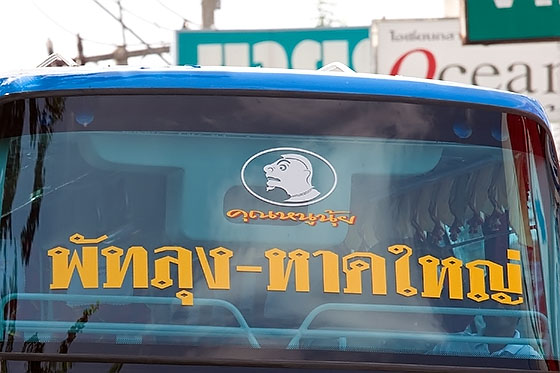Learn How To Read Thai - Tutorial 25
Transliteration
Attempting to transcribe words from one language into another language that has different sounds, and uses a completely different writing system, can only end in failure. However, there are better ways to do it compared to the methods that are currently used. Just why is it so bad?
There is evidence to suggest that when the original system was devised there was a lot of German input. Germans pronounce 'V' as 'F', and 'W' as 'V', hence 'Folksvagen' and not 'Volkswagen'.
I suspect this is why ว is often transliterated to 'V'. If there was a real 'V' sound in Thai (which there isn't) I suspect it would most likely be transliterated to 'F'.
Thai also has some vowel sounds that are similar to German umlaut sounds. With non-German keyboards you cannot type umlauts so it is acceptable to use the plain vowel followed by the letter 'e'.
An example would be 'schön', which can also be written 'schoen'.
'Ploen Chit' and the famous floating market tourist attraction at a place commonly transliterated as 'Damnoen Saduak' are just two such examples of this but there are many.
Thai has a perfectly good 'j' sound consonant but English words transliterated into Thai beginning with a 'j' sound get turned into 'y' sounds. Jeans (as in denim trousers) become 'yeens' in Thai.
Is it any coincidence that 'j' in German is pronounced 'y'? Ja? I rest my case!
To my way of thinking, this points to a lot of German influence. Unfortunately, this system only makes sense to those who have knowledge of reading German.
It is quite clear that whoever devised the system of transliteration had very little, or no, knowledge of English.
Place Names
Most foreigners in Thailand use transliterated versions of place names to pronounce the names of those places, and thus they can't be understood by Thais. When they talk among themselves they can be understood, but Thais don't recognise the pronunciations. This can be a problem outside of mainstream tourist resorts.
One of the things that frustrates me most is when I can only find transliterated versions of places names and, of course, Thais can't understand me. A quick look at the way the name is written in Thai tells me what I need to know but many reference sources don't provide the place names in Thai.
I criticise Lonely Planet often but a pat on the back to them for including place names written in Thai in their guide books. 99.9% of readers may not be able to read the Thai, but the Thai spellings are useful if you can read Thai.
I'll cover some of the places that are popular with foreigners on this page and if you aren't familiar with written Thai, you will start to see why the transliterated versions are incomprehensible to Thais.
Not only do the transliteration systems have poor phonetics, but they give no indication of vowel length. Along with tones, vowel lengths are extremely important in Thai. Also, syllable stress starts to become more obvious when you read the original Thai version.
In the following examples I will just give the standard transliteration, the word written in Thai, and what I think is a more phonetically accurate transliterated version. I could explain everything syllable-by-syllable but everything you need to know is in the previous tutorials.
If you have followed the previous tutorials you should be able to read all these signs and this page is just to give you practice reading real-world examples.
Kanchanaburi
กาญจนบุรี
gaan-juh-nuh-buu-ree
The stress is on the middle syllable when spoken by a Thai but with the standard English transliteration it tends to be on the second syllable. This particular example of transliteration is really bad.
In this popular province there is a river and a bridge that many tourists visit. It becomes 'Buffalo River' using the standard transliteration. Thais think this is funny.
River Kwai
The film title and the way that foreigners pronounce this place is wrong.
แม่น้ำแคว
mair-naam-kwair
Pattaya
พัทยา
put-tuh-yaa
The final syllable is long, unlike the standard transliteration. I wonder how many farangs live in places in Thailand whose names they can't pronounce correctly? I have heard many foreigners referring to this place as 'pa-TYE-ah' with stress on the middle syllable. Thais won't have a clue where you are talking about if you pronounce it that way.
Patong
ป่าตอง
bpaa-dtong
As a foreigner who can't read Thai, you are supposed to realise that the lack of 'h's in this place name indicate the initial consonants of both syllables are not aspirated. Is that clear? Also, there is no indication in the transliteration that the first syllable is long.
As a tourist many years ago, I remember seeing the Watergate Hotel in this district of Bangkok. Back then I didn't realise the significance.
Pratunam
ประตูน้ำ
bpruh-dtoo-naam
Being able to read some basic Thai is extremely useful in Thailand, and one of the most useful skills is being able to read destinations on buses, etc. Not all public transport has destinations written in English, especially away from the tourist resorts.
Phattalung - Hat Yai
พัทลุง - หาดใหญ่
put-tuh-luung - haat-yai
For a real example of this look at the photo at the top of the page.
Or perhaps you are going to Samui island and want to catch a bus to Surat Thani?
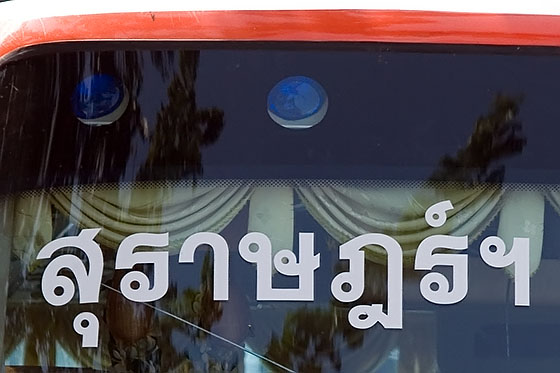
The origins of this place name must be from Pali or Sanskrit because it uses unvoiced consonants. One of the unvoiced consonants has gaa-run above it but the preceding one doesn't. It also uses bpai yaan-noy (Tutorial 21) to indicate that what is written is an abbreviated version. On this bus, only the first word 'Surat' is written.
สุราษฎร์ธานี - suu-raat taa-nee
The Thai spelling of this word is wrong in my version of Lonely Planet.
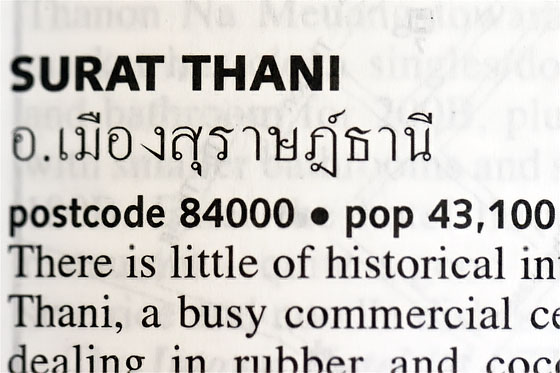
The taa-nee is straightforward. In surat there is a gaa-run symbol above the final ror reua in order to kill the consonant, but the consonant preceding ror reua (dor chadaa) is also ignored. This is something else to watch out for.
Can you see how standard transliteration systems completely ignore vowel length? Along with tones, vowel length is very important in Thai.
There is a town on the Thai/Malaysian border commonly transliterated as Padang Besar.
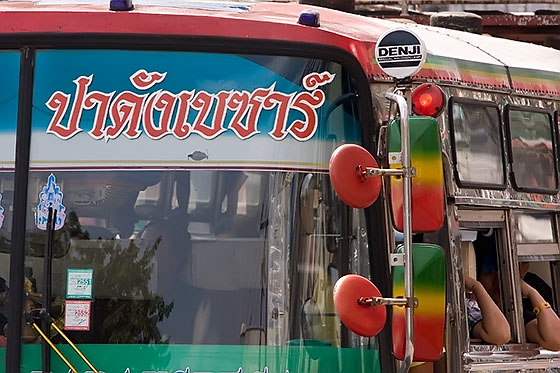
You should be able to see from the photo that bpaa-dung bay-saa is more accurate.
This one is the smallest (and maybe wettest) province in Thailand, I believe.
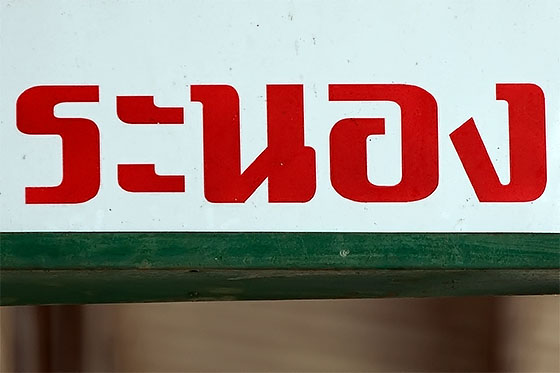
This one's easy but ror reua in Thai signs is normally written like an English 'S' instead of the Thai character you see printed in books. That is why I have used photos of real signs because if you just learn from books you will have problems as soon as you meet real-world fonts in Thailand.
ruh-nong or Ranong.
Most transliterations are just wrong; some on the other hand are completely and utterly wrong. Here's an example:
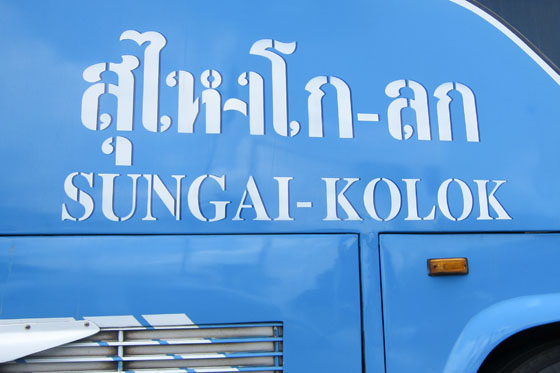
For a long time I only saw this place name written in English and I pronounced it the same way as all English speakers would pronounce it: sun-gai ko-lok.
It wasn't until I saw the name written in Thai that I realised this was completely wrong. When reading in Thai, you can see that after the 's' initial consonant and 'uu' vowel, there is no final consonant in the first syllable.
This is very clear when reading in Thai, and very wrong when reading the transliterated version.
suu-ngai go-lok.
The next location is a backpacker favourite, famous for its 'Full Moon' parties.
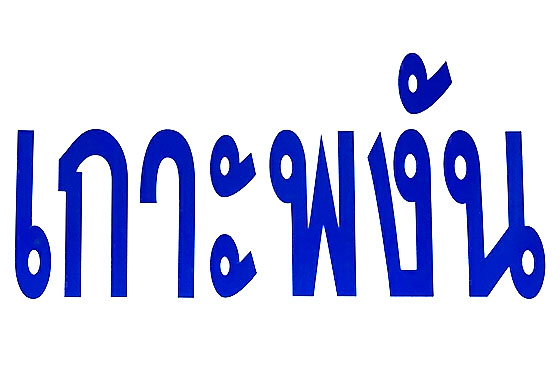
We have already met the first word which means 'island' in Thai (Tutorial 24). The second word (the name of the island) illustrates how reading Thai can be tricky sometimes.
It consists of four characters: Consonant, consonant, vowel, consonant
The first two consonants aren't a consonant cluster; therefore you need to add an implied vowel. It is not a single syllable word so the implied vowel is not 'o'. It is a two syllable word and the vowel in the second syllable is written. You therefore add an 'uh' sound in between the two consonants for the first syllable.
What we get is goh-puh-ngun. For most foreign speakers of Thai (including myself) the 'ng' sound as an initial consonant is difficult to pronounce. It is normally transliterated as Ko Pha-Ngan.
This one is a beach resort and the sign includes the province it is located in. You will notice that the bpai yaan-noy symbol has been used, so you know the name of the province has been abbreviated.
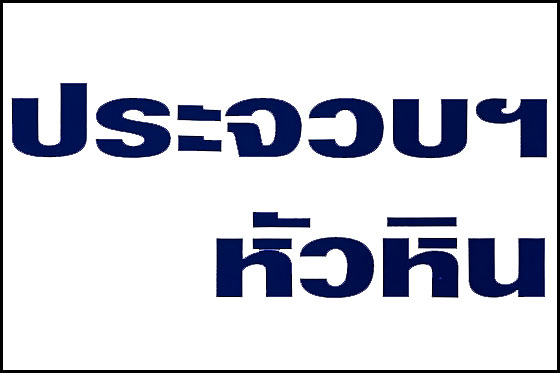
The first word is bpruh-joo-up. The second syllable uses wor wairn, which is normally used as a consonant, as a vowel. This is short for bpruh-joo-up kee-ree kun which is normally translated as 'Prachuap Khiri Khan'.
Can you see the problems with the transliterated version? The name doesn't begin with an aspirated 'P'; the second syllable is a 'J' sound, not 'CH'; and the transliterated version indicates short vowel lengths when some of the vowel lengths are long.
Transliteration makes use of the English letter 'H' to indicate aspiration but (as I have pointed out previously) this just confuses people, especially when an 'H' is written after 'P' or 'T' because in English those consonant clusters make very different sounds.
The second part of the sign reads hoo-uh hin (Hua Hin). This is an example of transliteration being fairly accurate.
This one is easy - another southern province.

Again, we have four characters: Consonant, consonant, vowel, consonant
The first two consonants do not form a consonant cluster, therefore we have to add an implied 'uh'. The second syllable isn't an aspirated 'T' but a 'DT' sound.
We get something like suh-dtoon (normally transliterated as Satun). The final consonant lor ling makes an 'L' sound as an initial consonant but an 'N' sound as a final consonant. However, I still see this transliterated as 'Satul' sometimes.
I also don't like sara oo transliterated as 'U' because in the absence of any other vowels, a single 'U' in English makes the same sound as 'U' in 'fun'.
There are a number of reasons why Thai to English and English to Thai transliteration simply doesn't work. While walking around my local branch of Index Living Mall I was interested to see the Thai transliteration for 'stool'.
The Thai transliteration is exactly the same as the Thai place name, Satun, but the sound of the two words is - of course - very different.

This sign includes the name in English but I have included it here to illustrate something.
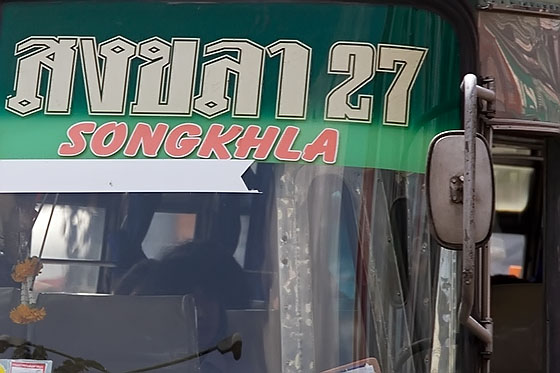
The province and town of Songkhla in the transliterated version uses the unnecessary and confusing 'H'. However, at the Prince of Songkla (no 'h') University, it is a serious 'crime' for any student to use an 'H' when writing the name of the university in English.
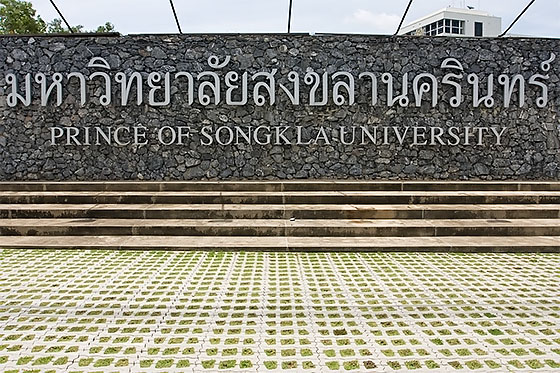
The word in Thai is exactly the same but depending on the context there are two ways to transliterate it. Why? Because monarchy is a very revered institution in Thailand and words related to royalty cannot be the same as words related to common things.
This is why there is a completely separate vocabulary in Thai just for matters relating to royalty.
English doesn't differentiate like this and I think it caused a bit of a problem for the Thais. Therefore, they have devised their own ways to differentiate when transliterating certain words.
Logically, there is no reason why words are transliterated the way they are but once you start to understand the Thai value system and how Thais think (which is completely different to how Westerners think), there are possible reasons behind the illogic.
The whole thing is a farce.
The bottom line is that transliteration systems are a complete waste of time for anyone who is serious about learning Thai. They probably help two-week tourists but that's about it. If you want to understand Thais you need to learn their language, and learning the written language is just as important as the spoken language.
Passages of written text are difficult for all manner of reasons, but it's not difficult to get to the level I have been attempting to teach in these tutorials. If you simply follow these tutorials and make an effort to memorise each one, you will soon be able to read menus and signs without any problem.
You still won't be able to pick up and browse Thai newspapers, but having even a basic reading ability is incredibly useful in Thailand.
Questions And Feedback
If you have any comments, questions or suggestions, feel free to contact me. Your feedback will help me to improve these pages.
Recommended Books
Amazon UK
Amazon UK
Amazon US
Amazon US

